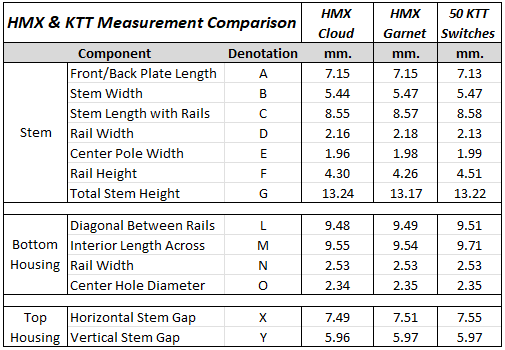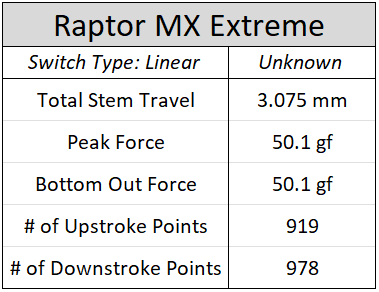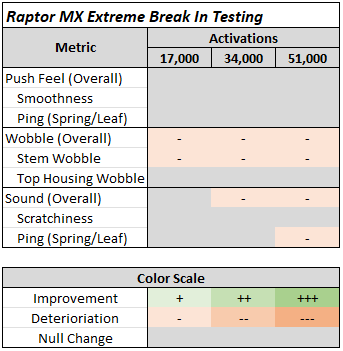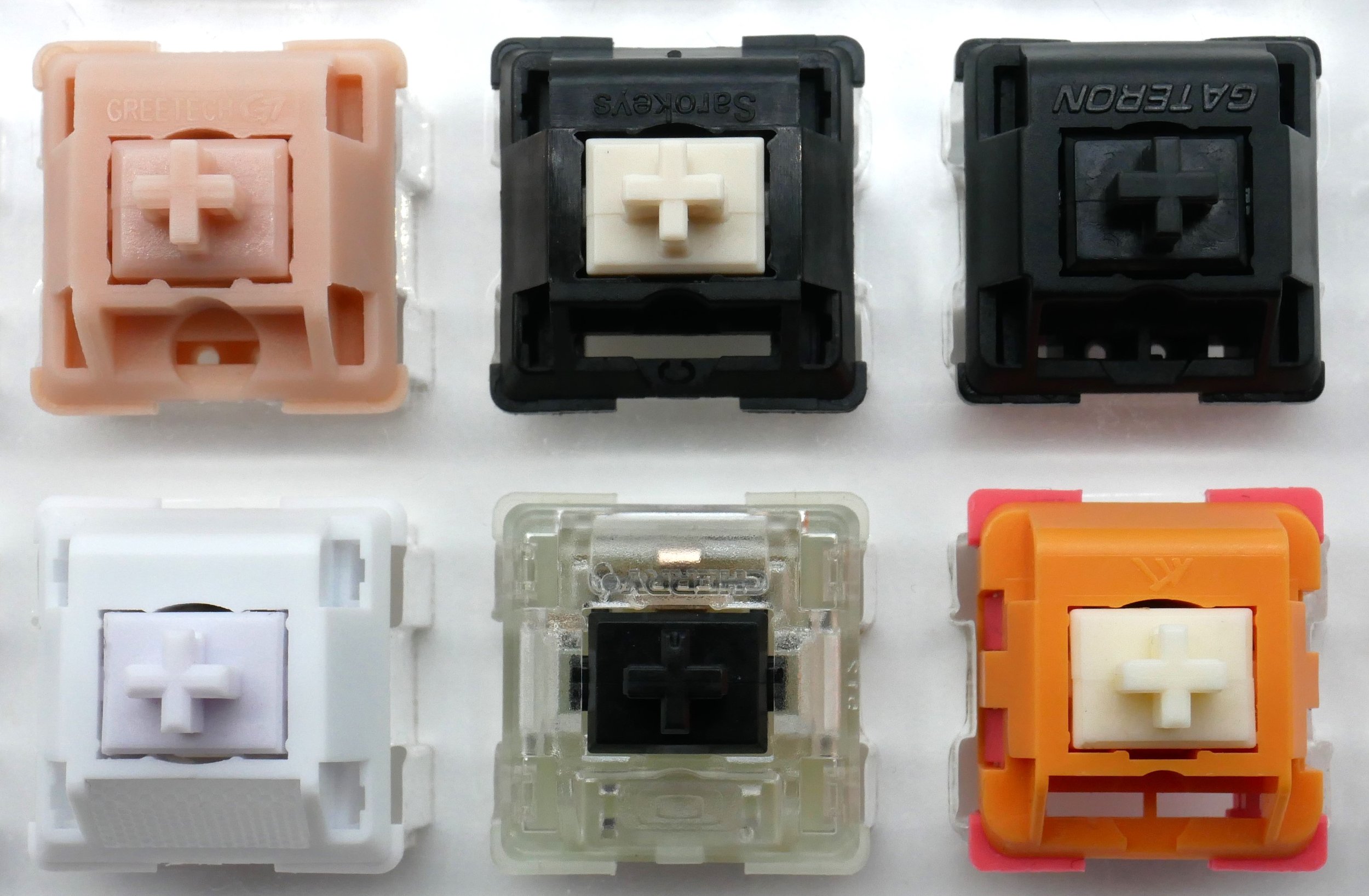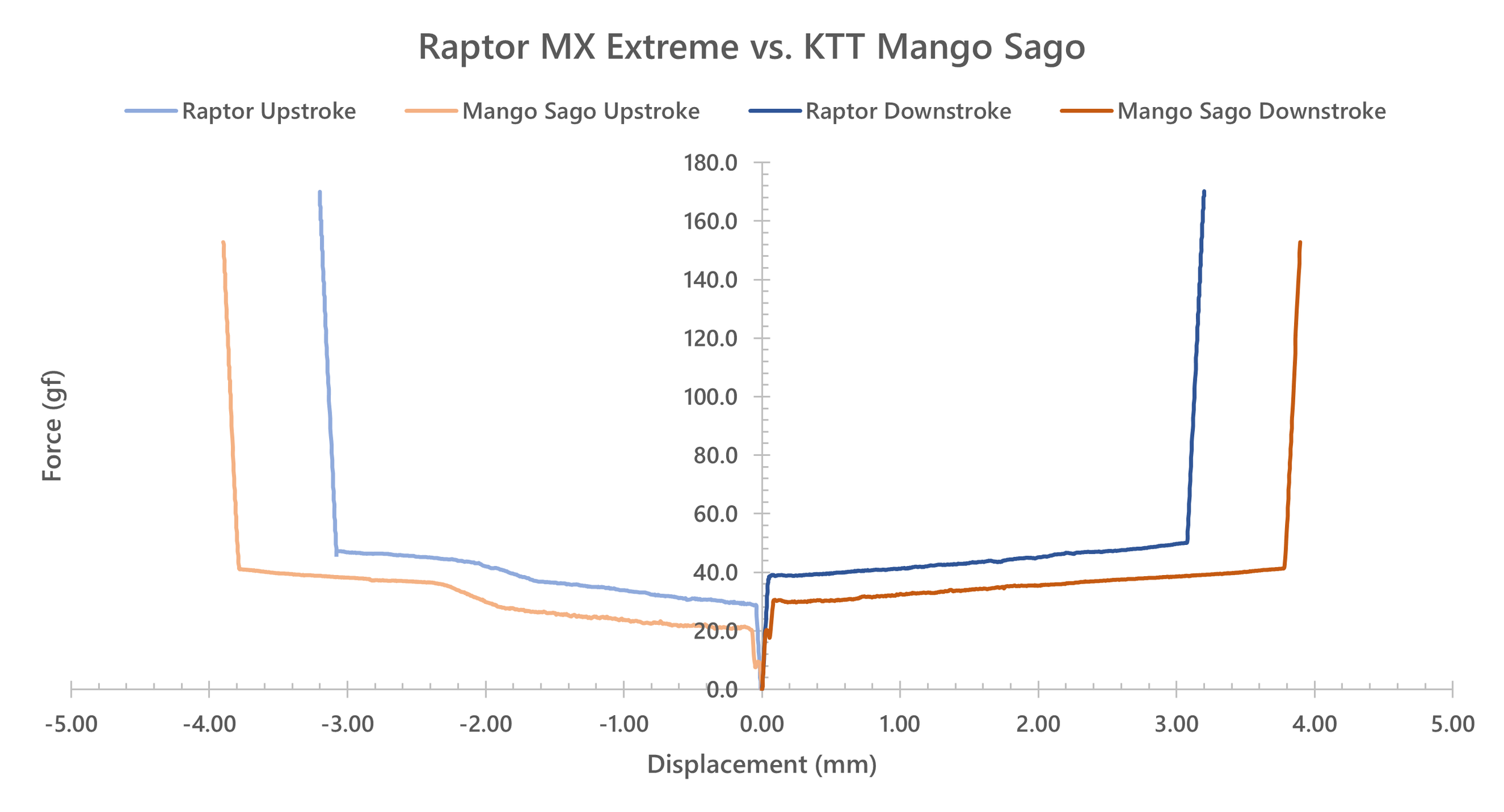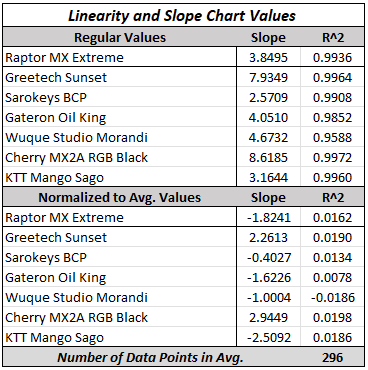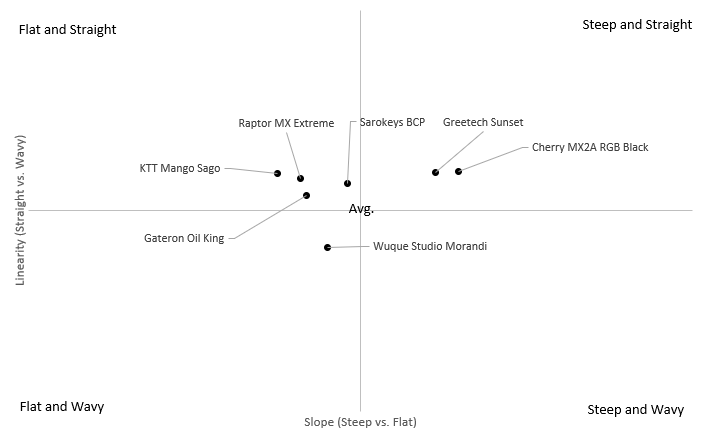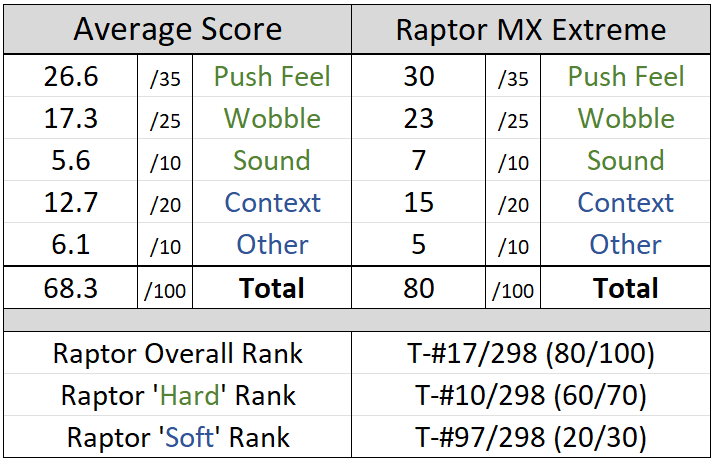Raptor MX Extreme Switch Review
I bet that at least a few of you thought that this review was going to open up with my take on the generational rap beef that has gone on over the course of the past few weeks between Kendrick Lamar and Drake. While I have certainly enjoyed the legendary back and forth between these two artists, and am glad that the loss in productivity from sinking into all the nitty gritty of the diss tracks occurred during one of my off weeks, it doesn’t quite feel as if it is my place to really make any sort of comments or Fantano-esque level critique of how I think that the beef has gone and/or is currently still going. Nor is it really my place to participate, either. Had Metro allowed for ghost written verses to be shared over his BBLDrizzy beat giveaway instead of openly rapped ones, though, then my participation might have been a different story. Speaking of ghost writing, though, I actually do have something keyboard related to pivot towards that will open one of these articles on a relevant foot for once. Specifically, I wanted to share a photo of the keyboard that I’ve been using to write this review and nearly every single page of content for the past 2.5 years now since people do like to ask me what I’m typing on quite often:
Figure 1: AKB Petrichor Prototype in Purple with GMK Zooted.
While the most dedicated of readers among you have likely seen me share this keyboard before, I can at least once more mention that I’ve been using a purple-colored prototype of the AlchemistKeyboards’ Petrichor for my daily driving over the past few years. Unlike every other time that I’ve shown off this F-rowless 1800, though, I am excited to share that you all are finally getting a chance to own your own as well. After years of development, several rounds of prototyping, and a whole lot of negotiations, James of AKB and Cannonkeys are finally releasing this board to groupbuy from June 14th through July 15th, with a range of colors well beyond what most boards offer these days. Never mind the fact that James has always been a personal friend of mine throughout my time collecting switches and that Cannonkeys is a direct sponsor of mine – I’ll vouch for this board purely from the fact that I’ve beaten it to hell and back over multiple years of time and it still works like the first day I’ve built it. Several hundreds of pages of writing, most of a grad school stint, and three different keycap sets later this board is still just what I want to come back to for yet another long winded review and the chance for you all to have a similar attachment to a board for less than $250 is something that I can’t let slip by without mentioning. The Petrichor is quite literally what I think of when I envision a daily driver board and now all you will get a shot at understanding why I feel that way. Don’t miss out on it.
Switch Background
For once in my long writing career, I think that I actually have some back-to-back review continuity when it comes to the historical relevance and contextual switch backgrounds and I very much aim to hinge the introduction to this section on such. For those of you who didn’t read the Everfree Grayish Tactile Switch Review in the past few weeks, it’s background opens up by discussing the weird grey area that exists when it comes to switch brands and if they are actually from distinct manufacturers or not. Of the ones that were listed in this introduction as being most convincingly independent and produced of their own accord, HMX was the one that I at least attempted to insinuate was the most convincingly real as a solo manufacturer. And by some very weird, totally coincidental and not planned at all twist of fate, I picked an “HMX-made” switch here in the Geon Raptor MX Extreme switches to further dive into HMX and the reason that I have to put “HMX made” into double quotes rather than single ones. (And no, it has nothing to do with BSUN even though the non-extreme version of Geon’s Raptor switches were made at BSUN.)
Figure 2: HMX 'Rainbow' switch marketing photo from initial ZFrontier tease.
Making their first apperance in the world of mechanical keyboard switches back in November of 2022, HMX, which is reportedly short for ‘Huimuxin’, debuted with a series of pastel colored ‘rainbow’ switches shown above that were teased by Marina-99 of ZFrontier. Unlike other newer manufacturers like Aflion who popped up suddenly and then slowly grew into their recognition that they have today, HMX hit the ground running and have released nearly a couple dozen different switches in the short 18 month span between then and now. Releases of specific HMX switches like the Hyacinth, Cloud, and Macchiato switches have started to gain such traction in recent months via offering in western-facing switch storefronts that the name of HMX – which was once a fringe, potentially brand-only name – has begun to gain some real mainstream curb appeal and recognition as an actual independent place. In fact, some vendors like Unikeys have made this a large part of their switch offering portfolios – pushing to stock each and every HMX switch that is produced out there alongside other known brands. From the jump, HMX has maintained their independence as a manufacturer of switches, though those among us that are a little more meticulous about their switches haven’t been as entirely convinced. Just take me as your perfect example of this; Upon doing research for this review, I had found that the pastel rainbow of “HMX-made” switches shown in the photo above were written down in my collection log as being made by KTT…
Even with claims of manufacturing independence in mind, the day one similarities between HMX and KTT switches at a mold-based level have been extremely hard to ignore. Sent to western collectors’ hands in the very same package as the KTT Strawberry V2 switches, the HMX Rainbow samples debut mold details that are not only identical to those of the KTT-made Strawberry V2 switches, but also have been present in a large number of HMX-made switches since. However, KTT has also seemed strangely avoidant of the molds and mold details shown in the Strawberry V2 switches since, having them not appear in any switch that I’m aware of since this debut alongside of the HMX Rainbow switches. Toss in some rumors that Sillyworks – the brand that is on the nameplate of the Hyacinth switches – had the first version of their switch “copied” by KTT and subsequently chose to move the V2 manufacturing to HMX, and this all starts to get even more confusing. KTT and HMX seemingly have existed in the same place at the same time, directly competing with each other for specific switch offerings, and yet both maintain strongly supported independence of each other. Unfortunately for you all, I don’t exactly have an answer to help clear up this confusion, either. Rather, all I have left is three potential realities that describe the relationship between HMX and KTT and my understanding as to why any of these three options could very well be the truth:
-1. HMX is a sub-brand produced by KTT
Aside from all of the mold-based similarities that could be pointed to across product lines, there are a few different reasons to suggest the simplest answer to all of this confusion is the correct one and that HMX is just a brand of switches produced by and at KTT. Chief among these is that both HMX and KTT seem to be competing in the same exact space of the switch market and doing so in damn near identical fashions. The bulk of releases by both HMX and KTT consist of budget-friendly, medium to light weight linear switches without many frills, solid performance metrics, and maybe some fun colors tossed in. None of these switches from either brand go out of their way to do revolutionary designs or spins on the MX-platform, invoke unique aesthetic concepts, nor reach out for big brand partnerships like larger production houses. As well, the linear switches that they do produce all just so happen to have the same weird design quirks that can be captured by caliper based measurement comparisons. As can be seen in the table below, the measurements I took for the HMX Cloud and Garnet switches seem convincingly similar to that of the averaged measurements of 50 different KTT-made switches. The rail height measurement comparison here is especially damning as no other manufacturer produces switches with rail heights as short as HMX and KTT. In fact, of the 50 shortest rail heights out of the 500 total switches I’ve measured to date, all but 5 are made by KTT with the Cloud and Garnet switches being 2 of those remaining switches.
Figure 3: Comparisons of component measurements between two HMX switches and the average KTT switch.
-2. HMX was connected to KTT and has since been cleanly separated.
While the idea that a brand new manufacturer could spin off from an existing one and carry molds and mold designs from one place to the next may seem like an odd concept to those outside of the switch enthusiast world, this isn’t all that unrealistic of a practice. A great example is that it is pretty well believed by now that Jerrzi, a newly formed recent switch manufacturer, separated from Huano in a similar fashion. As well, this transferring of knowledge and experience is also verifiably known to occur at the employee level as I’ve personally been privy to a switch designer that once worked for Outemu moving to Haimu and a sales representative for Tecsee moving to a smaller design brand of Qtuo Studio. Add in the fact that there is a pretty clean split about the KTT Strawberry V2 switch release where it seems like their mold offerings diverge, and you could presumably be convinced that KTT and HMX amicably split ways at one point in time. Whatever knowledge and experience transfer occurred during this split could reasonably explain why their baseline of offerings are so similar to each other and this split could also help shore up the known differences between their product lines. It’s pretty well documented that KTT currently has more tactile offerings that HMX. It’s also been suggested by Vere, a fellow switch reviewer with much more experience with HMX switches than I, that HMX is using proprietary blends of switch plastics in more of their offerings than KTT. To even further sprinkle some credence on this claim, I am also aware of a western-facing vendor who is supposedly making a visit to HMX soon as well – a factory which is listed in a different location and with different contact information than that of KTT.
-3. HMX was connected to KTT and the split was not clean.
Now this is the really far out there claim that may seem a bit surprising to put into text. However, there’s no reason to suggest that the reason KTT has yet to use Strawberry V2 molds since this weird split in time occurred was because they willingly relinquished their designs to HMX. In spite of the fact that HMX seemingly has these molds and at least can differentiate themselves from KTT in using them, that also hasn’t stopped them from making switches with other molds and mold-level details that are extremely similar to KTT switches released since this split. There’s a reason that the confusion about the connection of HMX and KTT is still cloudy to this day, and its not as if HMX has seemingly done much to try and differentiate their offerings from KTT-made switches. Let me go ahead and recall both the rumors about the Sillyworks Hyacinth switches above as well as the Stealios Controversy here in the same sentence to remind you all that the taking or copying of switch designs and/or molds isn’t all that far outside the realm of possibility for switch manufacturers, either. And while all of this speculation certainly feels fun to mull about, I would imagine many of you made it through this third point feeling like this is certainly the weakest of the possibilities that I’ve laid out. It’s a fun thought to believe that these waters dividing KTT and HMX are muddy for a reason and that the split may have some animosity behind it, but that’s just a bunch of rumors… right?
Figure 4: And you thought I would just insinuate that they had a hidden 11 year old daughter...
Released in late 2023 by GeonWorks, the “Raptor MX Extreme Gaming Switch” is the latest of a small family of ‘Raptor’ switches to be released by GeonWorks. All having red top housings emblazoned with a ‘GEON’ nameplate and black bottom housings and stems, the MX Extreme version of these switches are the lightest weight linears in the family, reported to be made by HMX, and are the cheapest among budget-friendly options at $0.36 per switch. While the nameplate and branding surrounding these switches certainly suggests longevity and significant market investment, its worth noting that the ‘Geon Raptor’ family of switches are effectively the third ‘family’ of offerings to be stocked by Geon over their few years offering switches, being preceded by the ‘Raw’ family and the basic, grey housing family of releases that were covered in my Lubed Black Geon Switch Review. Unlike these other families, though, it is worth noting that the Raptor family is unique insofar as it stocks a Hall Effect-compatible MX-mount switch, something which has never been catered to in a branded family of switches before. Like most other Geon-branded offerings, the Raptor MX Extreme switches are also available via other regional proxies including Divinikeys in the US, EloquentClicks in the EU, HyperBoring in CN, and Ktechs in SG. To the best of my knowledge, no other statements regarding the longevity, availability, nor expansion of the GeonWorks Raptor family of switches has been made as of the time of publishing this review.
Raptor MX Extreme Performance
Note: Due to the similarity in appearance of the Geon Raptor family of switches, please note that the MX Extreme switches covered here are not Hall Effect compatible. This review is not discussing the Raptor HE switches.
Appearance
At the highest level, the Raptor MX Extreme switches come in a translucent red over opaque black housing design with black stem in similar, but not identical fashion to the other switches in the Geon Raptor family. Surprisingly, this contrastingly sharp red and black housing scheme is fairly standout from most other modern switch offerings and thus these likely won’t be confused for other switches often from a far. Any closer inspection of them will certainly seal the deal, though, as the italicized ‘GEON’ nameplate clearly denotes their origin. The Raptor MX Extreme switches are easily differentiable from the Hall Effect variant of the family at a distance by the slightly lighter colored top housings as well as the presence of a through-switch LED slot. Beyond these most immediately striking details, there are still a few more details of note to be had about the Raptor MX Extreme switches, though at the mold-level. These mold-level details are covered in the paragraphs following paragraphs below.
Figure 5: Raptor MX Extreme switches and their components.
Looking first to the translucent red, polycarbonate top housings of the Raptor MX Extreme switches, these have very few details internally and externally that make them necessarily different from other modern releases. As was discussed above, KTT and HMX often strive for simplicity in their designs and execution, likely supporting the volume of switches they release as well as their relatively low price points across the board. Externally, the housings feature three points of note. First is the that of the ‘GEON’ nameplate that is not only stylized to match that of other GeonWorks products, but also matches that of other Geon-supported switches from other manufacturers. Second is the presence of the thin, rectangular LED/diode through-hole slot that spans the full width of the front of the housing and is not bifurcated nor indented. The final point of note to the top housings of the Raptor MX Extreme switches is that the mold marking is located on the bottom right-hand side of the outer edge of the LED/diode slot – a spot where this is commonly seen in KTT and HMX releases. Internally, the Raptor MX Extreme top housings don’t feature any details of note and the pictures below will suffice to capture all detail present.
Figure 6: Raptor MX Extreme top housing exterior showing stylized 'GEON' nameplate, thin rectangular LED slot, and mold marking in bottom right hand corner.
Figure 7: Raptor MX Extreme top housing internal design showing lack of unique design features that would separate it from either KTT or HMX releases of the past.
Moving next to the black POM stems of the Raptor MX Extreme switches, the most stand out combination of details is that of the lengthened stem pole and extremely shortened slider rails on the side of the stem. As was noted above in the ‘Switch Background’ section of this review, the extremely shortened slider rails of the Raptor MX Extreme switches are rather emblematic of KTT and HMX switch designs and rather definitively narrows down their maker even if not for the marketing clarification by GeonWorks. While the stem poles of the Raptor MX Extreme switches already appear quite long in contrast to the length of the stunted slider rails, their average measured length at 13.84 mm is substantially longer than the 500-switch average stem length I’ve measured to date of 13.08 mm. As a result, the total stem travel in the switch is substantially reduced compared to the standard 4.00 mm travel distance as can be seen in ‘Push Feel’ section, below. Beyond these two features, the only other points of note are perhaps that the slider rails are not tapered and that the center pole has a substantially larger tier than most other modern, MX-style stems I’ve covered recently. This isn’t entirely all that surprising for a KTT and/or HMX made switch, though it still worth noting. The Raptor MX Extreme switches do come factory lubed and when freshly opened from a switch, the factory lubing is quite heavily applied to all four sides of the stems.
Figure 8: Front and back side of Raptor MX Extreme stems showing front plate mold ejector circles, non-tapered slider rails, and long, strongly tiered center pole.
Finally arriving to the opaque black, nylon bottom housings of the Raptor MX Extreme switches, these too do not feature all that much that makes them distinctive from other KTT and/or HMX offerings of recent years. Internally, the bottom housings have small pads at the base of the guider rails to help soften bottom outs as well as a small south side spring collar to prevent the springs from rattling around when fixed into the housing – both very common features in switches these days. Externally, the Raptor MX Extreme switches come in 5-Pin/PCB mount construction with a small, two-digit number mold marking located upside down between the two metal PCB pins. As well, it does appear from the photographs below that there is a right side up and inverted ‘L’ mold marking in the bottom corners of the bottom housing exterior. However, unlike mold markings seen across the batch of these switches, these ‘L’ shapes do not change from switch to switch and must be a vestigial design feature or manufacturing remnant as opposed to a mold marking used in distinguishing their origin of manufacture.
Figure 9: Raptor MX Extreme bottom housing interior showing padding at base of slider rails, small south-side spring collar, and presence of heavy factory lubrication on the leaves.
Figure 10: Raptor MX Extreme bottom housing exterior design showing 5-Pin/PCB mount configuration and upside down, double digit numerical mold marking located between metal PCB pins.
Push Feel
Bottoming out at an incredibly stunted total stem travel distance of 3.075 mm, as opposed to the traditional full travel length for MX-style switches of 4.00 mm, it’s probably not hard to guess that the main crux of the push feeling in the Raptor MX Extreme switches is centered on the contact point between the stem pole and bottom housings. While I’m personally not much a fan of switches which bottom out in such a fashion, the Raptor MX Extremes do maintain a surprisingly light feeling bottom out that avoids a lot of the sharp, abrupt, and almost somewhat abrasive feelings that linears like this can have. By comparison, the Raptor MX Extremes bottom out with flat, firm, and somewhat glass-like housing collision that doesn’t feel as if it would fatigue on the fingers the same way that some long stem pole switches do. Perhaps the lack of sharp, aggressive tones in this bottoming out is a function of the lighter spring weight of the Raptor MX Extremes at approximately 50.1 grams of bottoming out force, however this feeling remains pretty consistent regardless of how hard I slam on the switches, which suggests otherwise. As well, it’s worth noting that this feeling is also pretty consistent across the batch of switches that I received and does not vary much, if at all, depending on which switch is being tested. The topping out of the switches also share a similar feeling to the bottoming out as a result of their polycarbonate construction, though it is substantially lesser in overall magnitude than the bottoming out.
Figure 11: Force curve diagram for stock Raptor MX Extreme switch.
The most pleasant surprise in the push feeling of the Raptor MX Extreme switches is their overall smoothness considering both their potential origins as well as the pretty substantial amount of factory lubrication used. While KTT has certainly produced linear switches that could be described as smooth over the years, it’s not until the last year or so that their factory lubing has improved to the point of dealing with the majority of scratch present in their linear switches. If HMX were to have actually separated from KTT, I would have imagined it would have taken them longer to match the improved lubing techniques of these recent KTT switches. The Raptor MX Extreme switches seem to suggest otherwise. The switches are pretty consistently smooth and free from scratch both within the full stroke of each switch and across the batch of different switches that I received. As a result of the heavy factory lubing, though, these switches certainly do feel lubed. The Raptor MX Extreme switches are not ones you would pick up, test out, and then later on be surprised to find out had lube inside of them – it’s a very clear and evident part of their push feeling in general slipperiness and resistance that can be felt in spite of their fairly light spring weight. With all of that in mind, though, these certainly are characteristics that would not only be okay but likely welcomed within the context of switches being priced in the budget-friendly option around $0.36 per switch. Finer tuning of the factory lubing and better balancing of the housings is something that could be expected of the Raptor MX Extremes if they were price higher than they are, but for where they are at they provide pretty damn solid performance for the price.
Sound
Like with all good mechanical keyboard switches before them, the sound profile of the Raptor MX Extreme switches pretty closely mirrors that of the push feeling notes above in that they are largely characterized by their bottoming out. While the Raptor MX Extremes have a smooth, glassy feeling to their bottom out, the sound of them is a just beyond medium pitched, medium-high volume slap-like sound that is flat in tone but with some warmer, softer components underneath of it. Do not let the fact that the bottom housings are marketed as being made of nylon fool you – you could more readily be convinced that they were made of polycarbonate or POM by your ears than by the common expectation of nylon housings. Further unlike the push feeling notes, the sound of the bottoming out does noticeably drift depending on the typing speed they are used at, with faster typing speeds leading to an upward shift in the pitch and a creeping sharpness that starts to prick at the ears a bit. However, without any scratch or spring ping noted at really any speed, it is hard to take too much issue with this shift in sound that is occurring only at elevated typing speeds and likely could be modified for via aftermarket mods or general board building considerations.
Wobble
Overall there is very little N/S or E/W direction stem wobble in the Raptor MX Extreme switches, though they are a little bit more variable between switches on this metric than any of the other metrics discussed above. The variation isn’t enough to necessarily warrant cherry picking should you want to build a full board out with Raptor MX Extremes, but it is enough for me to pick up on when I was taking testing notes on these switches for the review.
Measurements
If you’re into this level of detail about your switches, you should know that I have a switch measurement sheet that logs all of this data, as well as many other cool features which can be found under the ‘Archive’ tab at the top of this page or by clicking on the card above. Known as the ‘Measurement Sheet’, this sheet typically gets updated weekly and aims to take physical measurements of various switch components to compare mold designs on a brand-by-brand basis as well as provide a rough frankenswitching estimation sheet for combining various stems and top housings.
The latest in the content-adjacent work that I’ve picked up, the new ‘Force Curve Repository’ is now hosted on GitHub alongside the Scorecard Repository and contains all force curves that I make both within and outside of reviews. In addition to having these graphs above, I have various other versions of the graphs, raw data, and my processed data all available for each switch to use as you please. Check it out via the ‘Archive’ tab at the top of this page or by clicking any of the force curve cards above.
Break In
Break In Notes
17,000 Actuations
- After 17,000 actuations, the stem wobble in both the N/S and E/W direction in the Raptor MX Extreme switches has increased a tiny amount. It’s certainly not enough to move the needle on whether or not to use these switches, though I was able to separate them from their stock versions based on this metric.
- Perhaps the most notable change in the Raptor MX Extreme switches isn’t one that is necessarily bad nor good, and it has to deal with the bottoming out feeling and sound. Specifically, the switches broken in to 17,000 actuations have bottom outs that both feel and sound a bit sharper and more pointed than the stock forms of the switches.
34,000 Actuations
- The same notes that were had at 17,000 actuations can also easily be applied directly to the Raptor MX Extremes broken into 34,000 actuations as well. The pointedness of the bottoming out sound, however, begins to get a bit grating at this point in time and there’s enough of a gap growing between these and the stock switches at this point to make it noticeable.
51,000 Actuations
- Even in the face of certain lube migration throughout the break in process, the Raptor MX Extreme switches have stayed consistently smooth and haven’t had any switches which developed scratch throughout this testing.
- While there was a lack of push feeling changes as a result of lube migration, the Raptor MX Extreme switches broken in to 51,000 actuations definitely had the occasional flare up of pinging in their sound. This very well could be isolated to just a few specific switches that broke in significantly worse than the rest, though I still felt it was worth mentioning here.
Figure 15: Comparative force curve diagram showing no distinctive trend in change of Raptor MX Extreme force curve diagrams through the break in process.
Comparison Notes to Other Notable Linear Switches
Note – These are not aimed at being comprehensive comparisons between all factors of these switches as this would simply be too long for this writeup. These are little notes of interest I generated when comparing these switches to the Raptor MX Extreme switches side by side.
Figure 16: Switches for comparison. (L-R, Top-Bot: Greetech Sunset, Sarokeys BCP, Gateron Oil King, Wuque Studio Morandi, Cherry MX2A RGB Black, and KTT Mango Sago)
Greetech Sunset
- As a result of the shortened stem travel distance and pronounced bottoming out onto its stem poles, the Raptor MX Extreme switches feel much less subtle and are more distinctive than the Greetech Sunset switches. As well, the factory lubing present in the Raptor MX Extremes makes them more smooth than the Sunsets, which further accentuates this difference in bottoming out even more.
- In terms of stem wobble, the Raptor MX Extremes pretty substantially beat out the Greetech Sunsets in both N/S and E/W directions.
- The sound profiles of the Raptor MX Extreme switches, in both stock and broken in forms, are much more consistent, singular, and technically proficient than the Greetech Sunsets. By comparison, the Sunsets have much more noticeable scratch that develops as those switches are broken in further.
Sarokeys BCP
- While these two switches have similar bottoming out styles, the Raptor MX Extremes feel a bit more forceful and direct in spite of being slightly lighter weighted and requiring less force to achieve bottoming out. The BCP bottoming out, here, feels much more pointed, smaller, and pin prick-like as opposed to the larger, more round feeling collisions of the Extremes.
- Much like with the Greetech Sunsets above, the Sarokeys BCPs don’t hold a candle to the Raptor MX Extreme when it comes to stem wobble in either N/S or E/W directions.
- In terms of overall sound profiles, the Sarokeys BCPs are much more subtle, quiet, and sound as if they are constructed of much thicker housings than the Raptor MX Extremes which come across as thinner, higher pitched, and quite a bit louder in this comparison.
Gateron Oil King
- Both the Gateron Oil King and Raptor MX Extreme switches are smooth linears that have pretty substantial amounts of factory lubing. That being said, the Gateron Oil Kings definitely feel as if they are much more heavily lubed and have a slipperiness to their push feeling that isn’t felt in the Raptor MX Extremes.
- Surprisingly, the Gateron Oil Kings are a bit worse than the Raptor MX Extremes when it comes to both N/S and E/W stem wobble.
- The Gateron Oil Kings are on the complete opposite end of the sound profile spectrum than the Raptor MX Extreme switches. Oil Kings have deeper housing collisions with more bass heavy tones and a sort of dark, compactness to their sound as opposed to thinner, higher pitched, and brighter sounds of the housing collisions in the Raptor MX Extremes.
Wuque Studio Morandi
- In spite of the fact that the Wuque Studio Morandi and Raptor MX Extreme switches both have very similar force curves, the Morandi switches do not feel as if they punch the bottoming out with nearly the same sharpness and clarity as the Raptors seem to do.
- Of all of the switches on this comparison list, the Morandi are the closest to the Raptor MX Extreme in terms of N/S and E/W direction stem wobble, though the Raptors definitely do still take the edge on this metric.
- The same juxtaposition of overall sound profiles made above with the Gateron Oil King switches also definitely applies to the Raptor MX Extreme and Wuque Studio Morandi sound profile comparison here. The Morandi are just deeper, firmer, and more subtle switches that don’t pop out of the board to the ears quite the same as the Raptor MX Extremes.
Cherry MX2A RGB Black
- In terms of smoothness, the Raptor MX Extremes absolutely blow the Cherry MX2A RGB Black switches out of the water. To be entirely honest, this isn’t all that surprising given the general lack of lubrication that Cherry stock switches tend to have.
- Like every other switch on this list, the Raptor MX Extreme switches also edge out the MX2A RGB Blacks in terms of N/S and E/W direction stem wobble and not by a thin margin.
- While the topping out feeling of these two switches is decently similar, it’s hard to really draw any other through line between the two when it comes to their push feelings and sound. The MX2A RGB Blacks are more subtle, have bottoming outs with larger footprints, are scratchier, and just overall much more quiet and low key than the Raptor MX Extreme switches.
KTT Mango Sago
- Of all of the switches on this comparison list, the bottom outs of these two switches are the most diametrically opposed. The Mango Sagos almost don’t even feel as if they have a bottom out at all, which stands in sharp contrast to the pronounced, hard-hitting bottom out of the Raptor MX Extreme switches.
- The factory smoothness of these two switches is pretty similar, though there is a bit more scratch in the Mango Sago switches than the Raptor MX Extremes.
- As might have been expected from the first comparison note, the Mango Sagos are also much quieter and more subtle switches than the Raptor MX Extremes – both in terms of their push feeling at bottom out as well as their sound.
Linearity
If you are just now seeing this section for the first time and are a bit confused as to what I am talking about when discussing ‘Slope’ and ‘Linearity’, I highly suggest checking out my article titled ‘On Differences in Linear Switches’ where I explain what this section is for and how it came to be! For a bit of a shorter answer, know that this is part of my ongoing attempt to better quantify and articulate differences between linear switches which have historically not been captured in discussions about them.
Scores and Statistics
Note – These scores are not necessarily completely indicative of the nuanced review above. If you’ve skipped straight to this section, I can only recommend that you at least glance at the other sections above in order to get a stronger idea of my opinion about these switches.
Push Feel
Coming with pretty substantial lubrication from the factory, the Raptor MX Extreme switches are quite smooth light weight linears that feel a touch slippery from the lube but otherwise have no scratch in them nor across the batch. A significantly lengthened stem pole leads to a pole-first bottoming out that is forceful, flat, and just shy of pointed in feeling and is by far the most notable feature of this switch’s feeling. It is thankfully well balanced enough to just narrowly miss the prickly, sharpened feeling that some pole-first bottom out linears can and do pick up.
Wobble
The most technically proficient aspect of the Raptor MX Extreme switches is their stem wobble. Very little exists in both N/S and E/W directions and it is consistent from switch to switch.
Sound
Medium-high in both pitch and volume, the Raptor MX Extremes are entirely driven by the stem pole bottom out onto their nylon bottom housings and the avoidance of the prickly, sharpened feelings noted above makes this a much more pleasant experience. As well, no scratch is noticeable in the sound of the Raptors, though the contrast between the bottoming out and subsequent topping out onto polycarbonate housings is touch jarring.
Context
Perhaps the best overall point to be noted about the Raptor MX Extremes is that they pack all of these performance metrics into such a cheap price point at $0.36 per switch. While also widely available and supported by one of the largest vendors currently in keyboards, their lack of sticking to one particular switch design year over year makes me wonder if these switches will be phased out instead of supported as the shining examples that they could be.
Other
If HMX is its own factory, these switches are certainly a demonstration of their solo capabilities technically, though there is definitely still room to grow from the mold-level for them.
Statistics
If you are looking at this statistics section for the first time and wondering where the hell are the other 297 switches that I’ve ranked are, or what ‘hard’ versus ‘soft’ ranks refer to specifically, I’d encourage you to head on over to my GitHub linked in the table above or at the links in the top right hand of this website to check out my database of scorecards as well as the ‘Composite Score Sheet’ which has a full listing of the rankings for each and every switch I’ve ranked thus far.
Final Conclusions
The Raptor MX Extreme switches are surprisingly proficient demonstrations of all of the better aspects of the lightweight, long stem pole archetype in linear switches. While I have personally never been a fan of these types of switches because of the fact that their bottom outs often feel harsh, sharp, and substantially more aggressive than what I would want to deal with in a switch with a lighter spring weight, the Raptor MX Extremes have certainly softened my heart on this point a bit. These demonstrate very well that you can have a linear switch that bottoms out with 50 gf. at ~3.00 mm of stem travel while consistently maintaining a firm, not harshly pointed kick back at the end of the stroke. Tack on top of this the notably smooth overall finish of the switches and lack of effective stem wobble, and it’s hard to call these switches anything but great at what they were designed to do. If I were either KTT or HMX, I would certainly be speaking up about these switches now. If some of the more scandalous rumors about the split between these two factories are in fact true, here is a shining example for KTT to point to of HMX “stealing” their best efforts. After all, the things that make the Raptor MX Extreme switches technically great switches are all of the things that KTT built its reputation on over the past couple of years. On the flip side, if I were HMX, I’d definitely be seeing this as a chance to stake some claim to independence. Not only are these switches as good, if not potentially better than other premium KTT offerings, but they’re flexing these qualities from the sales page of one of the single largest keyboard vendors in the world. To be entirely honest, I’m surprised we’ve not heard more about these switches from any and all parties potentially involved – KTT, HMX, Geon, or the community at large. I have a feeling that these are still far from reaching their peak attention in the mechanical keyboard community – be it for their inherent qualities or external relations…
Sponsors/Affiliates
Mechbox UK
- A wonderful UK based operation which sells singles to switches that I’ve used above in my comparisons for collectors and the curious alike. Matt has gone out of his way to help me build out big parts of my collection, and buying something using this link supports him as well as my content!
KeebCats UK
- A switch peripheral company based out of the UK which sells everything switch adjacent you could ask for, they’ve been a huge help recently with my film and lube supply for personal builds, and they want to extend that help to you too. Use code ‘GOAT’ for 10% off your order when you check them out!
proto[Typist] Keyboards
- An all-things keyboard vendor based out of the UK, proto[Typist] is a regular stocker of everything from switches to the latest keyboard and keycap groupbuys. While I’ve bought things from the many times in the past, they also are a sponsor of my work and allow me to get some of the great switches I write about!
Divinikey
- Not only do they stock just about everything related to keyboards and switches, but they’re super friendly and ship out pretty quick too. Divinikey has been a huge help to me and my builds over the last year or two of doing reviews and they’ll definitely hook you up. Use code ‘GOAT’ for 5% off your order when you check them out!
ZealPC
- Do they really need any introduction? Zeal and crew kicked off the custom switch scene many years ago with their iconic Zealios switches and the story of switches today couldn’t be told without them. Use code ‘GOAT’ (or click the link above) for 5% off your order when you check them out!
MechMods UK
- A rising vendor based in the UK, Ryan and crew have been a pleasure to work with and have nearly everything you’d need to build your first or fourteenth keyboard. Go build your latest or greatest one right now with them by using code ‘GOAT’ at checkout for a 5% discount!
Dangkeebs
- A longtime supporter of the website and the collection, Dangkeebs has quite possibly the widest variety of switches of any vendor out there. Not only is their switch selection large, but it rotates and is constantly adding new stuff too. You’re going to need 5% off your order with my affiliate to save off the cost of all those switches!
SwitchOddities
- The brainchild of one my most adventurous proxies, SwitchOddities is a place where you can try out all the fancy, strange, and eastern-exclusive switches that I flex on my maildays with. Follow my affiliate code and use code ‘GOAT’ at checkout to save 5% on some of the most interesting switches you’ll ever try!
Cannonkeys
- Does anybody not know of Cannonkeys at this point? One of the largest vendors in North America with keyboards, switches, keycaps, and literally everything you could ever want for a keyboard always in stock and with an incredibly dedicated and loving crew. Follow my affiliate link above in their name to support both them and I when you buy yourself some switches!
Kinetic Labs
- One of the most well-rounded keyboard vendors out there, Christian and crew have been supporters of all my switch and switch-adjacent needs for some years now. I’m honored to have them as an affiliate and think you should check them out using my affiliate link above to support both them and I when you check out their awesome products!
Keebhut
- Want to try out some switch brands that fly under most vendor’s radars? Keebhut is always seeking out that next latest and greatest and has been super helpful in hooking me up with new brands over the past year. They are all about sharing that love as well, and want to give you 5% off your next order with them when you use code ‘GOAT’ at checkout!


